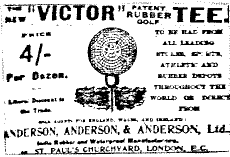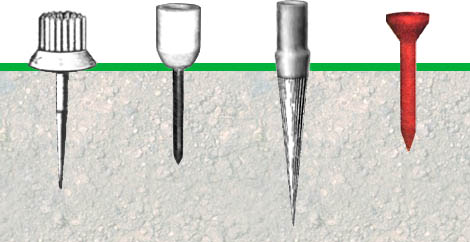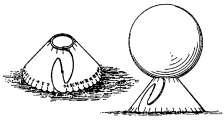Who invented the golf tee?
World's first golf tee patent
In the early days of golf, golf tees as we know them today were not part of the game. To elevate the ball for a drive, one had to build a tiny mound of dirt or sand and balance the ball on top. Fed up with this messy nuisance, a few golfers broke with tradition and tried using portable manufactured tees. Among the experimenters were two Scots, William Bloxsom and Arthur Douglas, inventors of the first patented tee in the world. Their patent document is dated 1889 and describes a small rubber plate with a raised ball support in the form of upright prongs or a hollow cylinder. Most early tees were similar to this one in that they lay flat on, but did not penetrate, the ground.

Peg tees
 Tees that sat on top of the ground had an annoying tendency to fly away upon getting smacked with the club. A solution, advertised in British golf journals of the 1890s, was the use of peg-shaped tees that could be pushed into the ground. The first of these gadgets to hit the market was the "Perfectum," a rubber-and-iron peg with a crown of rubber pins upon which the ball rested. Its inventor was Percy Ellis of Surrey, England, who took out a British patent for his creation in 1892. The related "Victor" tee, with a cup-shaped rubber head and metal spike base, was patented in 1897 by PM Matthews of Scotland.
Tees that sat on top of the ground had an annoying tendency to fly away upon getting smacked with the club. A solution, advertised in British golf journals of the 1890s, was the use of peg-shaped tees that could be pushed into the ground. The first of these gadgets to hit the market was the "Perfectum," a rubber-and-iron peg with a crown of rubber pins upon which the ball rested. Its inventor was Percy Ellis of Surrey, England, who took out a British patent for his creation in 1892. The related "Victor" tee, with a cup-shaped rubber head and metal spike base, was patented in 1897 by PM Matthews of Scotland.
"Perfectum"
(1892)
(1899)
"Reddy Tee"
(1922)

An early tee designer who gets a lot of attention today in websites and the popular press is Dr. George Grant, the first black graduate of Harvard's dental school. His version of the tee, patented in 1899, consisted of a vertical rubber tube attached at its base to a carrot-shaped piece of wood. It was not the first-ever golf tee as is often claimed, and in fact did not differ much from the earlier pegs that similarly combined a flexible ball rest and a rigid ground anchor. Since Grant did not sell or promote his handiwork, it went unnoticed by the golfing public.
The modern tee
While the turn of the 19th-20th century saw many tee inventions of various forms and materials, none of these novelties grew popular enough to threaten the centuries-old tradition of the sand tee. That situation began to change in the early 1920s, when New Jersey dentist William Lowell patented and sold a tee that would eventually become standard: the familiar one-piece wooden peg with a funnel-shaped head. The "Reddy Tee," as Lowell called it, was easy and cheap to mass produce, but most important to its success was Lowell's aggressive marketing campaign, which included hiring golf great Walter Hagen to show off the tees while touring.
Because of the Reddy Tee's unprecedented acceptance at both the professional and amateur levels, Lowell was for some time assumed to have been the inventor of the golf tee. More recently it has become fashionable, especially during Black History Month, to give George Grant the credit. Few people are aware of the tees preceding both Grant's and Lowell's, and as of this writing, scant reference to them can be found elsewhere on the Web. For a reasonably complete history, find the book Singular History of the Golf Tee by Irwin R. Valenta (Greensboro, N.C. : I.R. Valenta , c1995).
Appendix: Patent details
The list of patents below covers only the tees discussed on this page. More extensive patent lists can be found in Valenta's book. One should keep in mind that patents are not necessarily "firsts": surely there were golfers who fashioned makeshift tees out of paper or cork, or whittled pegs out of sticks, without seeking patent protection.
| Application Date | Issuer & Patent No. | Inventor | Location | Type |
|---|---|---|---|---|
| 16-Aug-1889 | GB 12941 of 1889 | Bloxsom & Douglas | Scotland | Rubber plate with raised ball seat. World's first tee patent. |
| 29-Feb-1892 | GB 3916 of 1892 | P. Ellis | Wallington, Surrey, England | Rubber head, metal spike |
| 10-Sep-1895 | US 567455 | D. Dalziel | Glasgow, Scotland | Rubber tee combined with artificial-turf mat. First US tee-related patent. |
| 16-Dec-1895 | US 570821 | P.L. Senat | Phila., PA | Truncated cone made of paper or cardboard. First tee patented by US citizen. |
| 12-Jun-1897 | GB 14292 of 1897 | P.M. Matthews | Scotland | Cup-shaped rubber head, metal spike |
| 1-Jul-1899 | US 638920 | G. Grant | Boston, MA | Tubular rubber head, wood spike |
| 5-May-1922 | US 1493687 | W. Lowell | S. Orange, NJ | Wooden peg with concave, funnel-shaped head |
The first United States patent relating to a golf tee belonged to David Dalziel of Glasgow, Scotland. The patent was for a cylindrical, concave-tipped rubber tee in combination with an artificial ground surface (similar to the setup one might find at a driving range).

The first American to secure a golf tee patent was Prosper Senat, an artist from Philadelphia. His tee was a C-shaped card joined at its ends to form a truncated cone. Along its edges were notches and markings to help the golfer keep score.